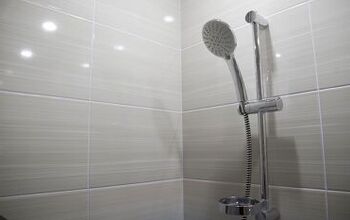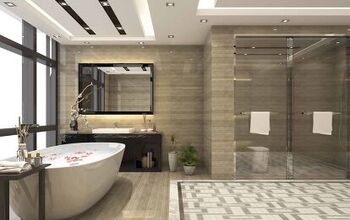What Is The Best Adhesive For Shower Tiles?

When you’re tiling your shower, there are two things that you want to be sure of. The first is that you want your shower to be waterproof. The second is that you want to make sure that your shower tiles actually stick. That’s why so many people want to know what the best adhesive for shower tiles currently is.
Thinset mortar with a latex additive is the best adhesive for shower tile. Pre-mixed mastic is a great adhesive to use if you have small shower tiles. Thinset is the best choice because of the moisture resistance, fast dry time, and stiffness.
Understanding the perks and pitfalls of shower tile adhesives is what you need to do. Our guide will give you a quick run-through for most shower tile conundrums, as well as some important notes.
What Is The Best Adhesive For Shower Tiles?
The general consensus is that the best adhesive for shower tiles of all sizes tends to be thinset mortar, often augmented with a little latex to add flexibility. Thinset mortar is the go-to for almost all shower tiling projects, and if you ask people at the Home Depot, they’ll usually agree.
If you are looking to use smaller tiles or a unique layout that involves square tiling away from the actual shower, a pre-mixed mastic might also work well. However, this is only a good option if you are working with distant shower walls and not a bathroom floor. Mastics are generally not waterproof, so you want to avoid them if possible.
Thinset Benefits
Most plumbers strongly suggest thinset, simply because of its benefits, even though you often have to mix them yourself. Thinset mortar with a little acrylic has a lot of perks, including the following:
- Strong Bonds. Good thinset will bond with virtually any type of tiling that you could imagine. Ceramic, glass, and just about every other type of tiling can be matched with it.
- Quick Drying. If you are doing shower walls, you can usually get away with using a mastic because you won’t be stepping on the walls However, you may have trouble with flooring because it can take days to cure. Thinset mortar is quick-drying, which makes it easier to work with on all surfaces.
- Good For Evening Dips. Minor dips can also be evened out by thinset, primarily because it’s dimensionally stable enough to afford a little extra.
- Moisture-Proof. Here’s the big draw for thinset that everyone acknowledges. It’s moisture-proof, so you won’t have to worry about walls getting moldy after tile’s set in.
- Wide Variety Of Materials. You can bond almost any type of material, even glass, to a wall using mortar.
Downsides
Thinset’s biggest drawback is that it’s hard to work with. Since you will need to add support to the tiles before they dry, you have to be extra careful when trying to adhere tiles. This is why many people prefer to look for mastics if at all possible. It’s just a tricky material.
What is Mastic?
Mastic is an acrylic adhesive that is best thought of as being similar to glue. It is a non-cementitious material, with its own unique set of pros and cons. The primary advantage to using mastic is the setting time and “stickiness” of the product, allowing for quick and easy tile installation.
This type of adhesive can be used on glass, ceramic, or porcelain tiles. While older mastics were derived from the resin of a shrub, modern mastics are inorganic and contain calcium carbonate and acrylic copolymers. The organic compounds in older mastics is why these varieties tend to break down over time.
Mastic Benefits?
Though thinset is a great go-to, sometimes, getting a pre-mixed mastic is a better idea. Mastics are good for people who are okay with slow-drying bonding agents as well as for people who are using smaller tiles. Here’s why:
- Fast Bond With Small Items. Subway tiles, square tiles, and “brick” tiles are very easy to set with mastic, simply because they have a near-instant bond with them.
- Slow Drying. Since this type of adhesive dries slowly, you can make a lot of adjustments without feeling pressed for time.
- Pre-Mixed. Pre-mixed mastics are ideal for people who want to just get gluing, and are concerned that they may not be able to mix it correctly. It’s just “open and go.”
- Better For DIY. Though thinset can be used by DIYers with great success, most people who use them can find them hard to work with due to the fast drying times. Mastics are better for people who need to work out a control for their stuff.
- Bad With Water. If the area of your shower will be exposed to a lot of water, you shouldn’t use a mastic. Thinset will be the way to go. However, it can make a great sink backsplash adhesive.
- Ceramic + Porcelain Only. Mastics generally should only be used to bond ceramic and porcelain tiles.
Downsides
Aside from it being difficult to work with when it comes to material variety, mastics are really not meant to be used in areas where heavy waterfall will happen. This makes them more at-risk for floors and wet walls. However, if you want to do a shower ceiling or the outside of a shower, they might be an OK option.
With that said, mastic is often best used for kitchen walls or any situations that will have little to no water applied to the surface of the tile.
What Type Of Mortar Should You Use?
If you love the idea of thinset but want to delve deeper into specifics, we get it. Mortar isn’t just one type of adhesive. It tends to be a wide range of different subcategories. If you’re going to go for a special type of thinset, these options below might do the trick:
- Epoxy Tile Mortar. Epoxy is great for resin-backed stones, and also has an amazingly high compressive strength. That being said, these mortars take a long time to cure and can have a strong smell while they work.
- Unmodified Mortar. Unlike thinset, unmodified mortar doesn’t involve additional polymer additives. It’s an old-school mixture that is known for being slightly less flexible but still more workable than mastics.
- Modified Thinset. This is thinset that has latex and other additives added to it, which makes it more flexible and waterproof than your typical adhesive. We strongly suggest this for flooring as well as places of heavy traffic.
- Large Tile Thinset. If you have tiling that’s over 15 inches on one side, congratulations. You have what is known in the industry as an LHT, or a Large Heavy Tile. This means that you are going to have to get a thinset that’s specifically designed to uphold the bond of a larger tile. It’s usually written on the thinset tub, so you can pick out the right one for you.
Professional Help
If you are not sure what type of adhesive you need to use for a specific type of shower tiling install, then ask a professional at your local hardware store. Because it’s so important to choose the right adhesive, getting a second opinion is the best way to make sure that your tiling work stays good for years to come.
Our Final Take
While mastics can be good for getting nice mosaics in and around the shower area, the truth is that you should get thinset if you want to have a bathroom that looks great. Since thinset is water-resistant, capable of working with a wide range of materials, and also cures quickly, it’s usually your best candidate. Heck, that’s why it’s the standard adhesive type for showers.
Though getting thinset of any type will work well, the best results will be achieved by getting the right subcategory for your specific project. So, take the size, material, and overall build of your tiles and background into account. If you’re still feeling stumped while shopping, ask a pro. That’s what they’re there for.
Related Questions
Are mortar and Thinset the same thing?
Thinset is a type of mortar that is specifically ideal for tile. Mortar is an adhesive cement used to secure wall and floor tiles to concrete. Both terms are often used interchangeably to describe mortar.
Can you use Liquid Nails to install tile?
There are specific types of adhesives manufactured by Liquid Nails that are designed for use on tile. Since tile cannot be stapled, screwed, or nailed in place, adhesive is the only method for attaching them.Using liquid nails, as opposed to another type of mortar, can be difficult for mounting tiles due to the long working time. The adhesive on each tile must have ample time to vent.
What’s the best type of tile for shower walls?
Quarry, porcelain, or ceramic tile are the best tiles for shower walls. They are each considered to be in the ceramic family, and they have superior water resistance.

Ossiana Tepfenhart is an expert writer, focusing on interior design and general home tips. Writing is her life, and it's what she does best. Her interests include art and real estate investments.
More by Ossiana Tepfenhart



























